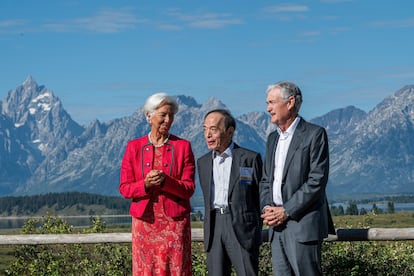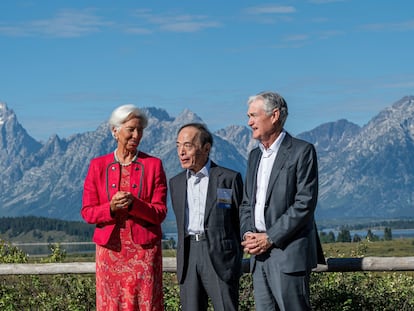Why are central banks insisting on a 2% inflation target, a percentage that was born in New Zealand?
Inflation expectations are still high despite the squeeze on monetary policy. A target of 3% would be more in line with the economic reality left by the pandemic and climate change, but it is not possible right now

Ten back-to-back rate hikes later, inflation in the eurozone remains above 5%, still far from the 2% target chased by the ECB. In the U.S., after an increase in the cost of borrowing by 525 basis points in the last year and a half, prices continue to grow at a rate of 3.7%, also above the target the Federal Reserve aspires to. And in Japan, a country mired for decades in low growth without inflation, the CPI stands at 3.3%. This figure is also above the 2% set as a target by the Bank of Japan, the only central bank in the developed economies that has allowed itself not to raise rates in the global inflationary spiral.
Central banks have triggered the biggest wave of rate hikes in decades in pursuit of the perfect 2%, the ideal level at which they believe inflation should be set in a perfect world of price stability. And for the sake of that stability, central banks are willing to sacrifice growth with tight monetary policy that will take time to ease. As long as it takes to bring inflation back to that specific target of 2%.
Today, 2% inflation is a common and unquestionable target for central banks around the world, but this was not always the case. Nor does it have its origin in strictly scientific reasons. The benchmark of 2% that central banks so revere emerged in New Zealand, the result not of a thoughtful monetary investigation but of a television interview.
In 1988, New Zealand was suffering from inflation rates of 10% which, at the time of the interview, had reached 15%. Then-Prime Minister Roger Douglas told the cameras that inflation should ideally range from zero to 1 percent. At a time when there was no specific monetary policy benchmark on price targeting, the New Zealand Federal Reserve took note of that desire and set a target limit for inflation of 2%, which years later would be replicated around the world. Even so, it would take a while to become the mantra of the world’s most influential central bank. In the 80s, when Paul Volcker took U.S. rates to 19%, there was no concrete target for inflation, and it was not until January 2012 when the Federal Reserve embraced the 2% target, under the chairmanship of Ben Bernanke.
Timid debate
At a time when the tenth interest rate hike by the ECB threatens to precipitate recession in the eurozone, the debate on whether to insist on the 2% inflation target is back in the news. Even more so when the ECB itself has acknowledged that it erred in its prediction that inflation was going to be a transitory phenomenon, and when traditional economic and monetary models creaked under the weight of new and overwhelming phenomena such as climate change and the reversal of globalization. China is no longer the cause of falling prices that it was before the pandemic, when there was no problem in offshoring production chains. And extreme weather events, with increasingly frequent droughts and floods, are putting pressure on food prices.
Last August, the Jackson Hole monetary policy forum timidly hosted some debate on the sacrosanct objective of price stability. The leaders of global monetary policy did not budge one inch from their commitment to 2% inflation, although Federal Reserve Chair Jerome Powell marked out where such a hypothetical revision of that objective could go. This would necessarily have to be done in the context of the bank’s strategy review, which will not take place until 2025, and will only make sense if the current 2% price stability target has been achieved. For her part, Christine Lagarde, president of the ECB, acknowledged that “an era of changes in economic relations and ruptures of established patterns could be beginning.” She mentioned the likelihood of “further shocks from the supply side,” such as the sharp rise in commodity prices, and the greater investment needs imposed by climate change, both of which are inflationary factors.
So far, the latest strategy reviews by the Fed and the ECB, both prior to the pandemic, have injected minimal doses of flexibility into the goal of price stability. The Fed set it at an average inflation of 2%, leaving room for times when it may be above or below that level. And the ECB went from talking about inflation below but close to 2%, to a symmetrical 2% target in the medium term, in a sort of small upward adjustment.
Credibility at stake
“Now the priority of central banks is to anchor inflation expectations, which are still above 2%. Its credibility cannot be risked, and the approach of any change must be based on the results of a thorough analysis. The global economy is undergoing structural changes of great magnitude, and we must make a good diagnosis of what is happening. The error in inflation forecasts after the pandemic was widespread,” explains Sonsoles Castillo, economist at BBVA Research.
For Raymond Torres, director of economic situation at Funcas, “it is perfectly understandable that central banks are defending their 2% target. Otherwise, they would lose credibility.” But he also points out that a new inflation target of 3% would lower the risk of damaging growth, and then having to undertake more aggressive rate cuts, while being a more affordable level to anchor inflation expectations. Once the upward spiral of prices has been unleashed, it becomes very difficult to redirect it: high rates of inflation feed consumers’ expectation of higher prices in the future. In the words of the governor of the Bank of Spain, Pablo Hernández de Cos, “when the genie of inflation is out of the bottle, it becomes more and more difficult to put it back in.” With current inflation rates, everyone reacts to price increases, but with inflation of between 2% and 3% they are not so sensitive. “3% is at the threshold where people forget about inflation,” says Torres.
In the current environment, the non-negotiable target is 2% in the medium term. Looking ahead, as Lagarde pointed out in Jackson Hole, it would be necessary to continue to have clear objectives, with flexibility in analysis and humility when communicating them. “The difficulty is not in new ideas, but in escaping from old ones,” Lagarde concluded her speech, paraphrasing John Maynard Keynes.
Sign up for our weekly newsletter to get more English-language news coverage from EL PAÍS USA Edition
Tu suscripción se está usando en otro dispositivo
¿Quieres añadir otro usuario a tu suscripción?
Si continúas leyendo en este dispositivo, no se podrá leer en el otro.
FlechaTu suscripción se está usando en otro dispositivo y solo puedes acceder a EL PAÍS desde un dispositivo a la vez.
Si quieres compartir tu cuenta, cambia tu suscripción a la modalidad Premium, así podrás añadir otro usuario. Cada uno accederá con su propia cuenta de email, lo que os permitirá personalizar vuestra experiencia en EL PAÍS.
¿Tienes una suscripción de empresa? Accede aquí para contratar más cuentas.
En el caso de no saber quién está usando tu cuenta, te recomendamos cambiar tu contraseña aquí.
Si decides continuar compartiendo tu cuenta, este mensaje se mostrará en tu dispositivo y en el de la otra persona que está usando tu cuenta de forma indefinida, afectando a tu experiencia de lectura. Puedes consultar aquí los términos y condiciones de la suscripción digital.
More information
Archived In
Últimas noticias
Most viewed
- Sinaloa Cartel war is taking its toll on Los Chapitos
- Oona Chaplin: ‘I told James Cameron that I was living in a treehouse and starting a permaculture project with a friend’
- Reinhard Genzel, Nobel laureate in physics: ‘One-minute videos will never give you the truth’
- Why the price of coffee has skyrocketed: from Brazilian plantations to specialty coffee houses
- Silver prices are going crazy: This is what’s fueling the rally











































